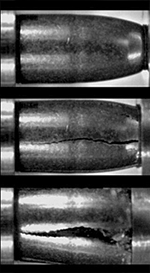Frangible bullet

Frangible bullets are intended to disintegrate into tiny particles upon target impact to minimize their penetration of other objects. Small particles are slowed more rapidly by air resistance, and are less likely to cause injury or damage to persons and objects distant from the point of bullet impact.
Most
Manufacturing

Alternative manufacturing techniques include sintering (heating and compressing powdered metals at temperatures below the melting point), or binding the powdered metal with an adhesive polymer in an injection moulding machine.[5]
Target damage
The mechanism of bullet disintegration varies with the energy transfer at the time of impact. With sufficient velocity, bullets may be vaporized upon impact. Few firearms can propel bullets at sufficient velocity to cause reliable vaporization at the target, and air resistance causes bullet velocity to decrease with increasing distance from the firing point; so frangible bullets typically rely upon other mechanisms for disintegration at lower velocities. Target characteristics are an important aspect of interaction with the bullet. Energy available to initiate the disintegration mechanism is limited by the rate at which the target slows the bullet; so bullets may pass through flexible, fragile or low-density materials without slowing the bullet enough to cause disintegration. Bullets must resist disintegration during handling, loading, and firing to reliably hit the target; so high-velocity loads may require a non-frangible jacket to protect a frangible core from disintegration prior to target impact. The jacket may ricochet, but should have reduced range without the weight of the frangible core.[5] Frangible hollow-point bullets may penetrate clothing, drywall, and light sheet metal; but often disintegrate upon striking glass.[6]
Hard targets may be damaged by frangible bullets. Extent of damage increases with velocity of bullet impact. Energy transfer at the point of impact may break brittle targets, and may temporarily soften and permanently deform malleable materials. Target crystalline structure may be changed to increase target damage by subsequent bullets. Steel targets designed to withstand rifle ammunition may be damaged by bullet velocities over 2,700 feet (820 m) per second; and lower velocity bullets may damage steel targets intended for pistol or rimfire ammunition.[5]
Frangible bullets striking animal targets create wounds similar to conventional bullets.
Frangible bullets may represent an unconventional threat to
Uses
Frangible bullets offer improved safety for specialized combat simulation training, which involves one or more shooters engaging multiple
History
Injuries from lead bullet fragments ricocheting off metal targets at 20th-century
In the early 21st-century, the United States military began using frangible bullets to reduce ricochet risk during small arms training. These bullets use nylon as a binding agent for a core of powdered copper and tungsten contained within a gilding metal jacket.[13] A tungsten/nylon projectile core was developed by Ecomass Technologies to replace the lead core in the 3-part M855 5.56mm projectile and placed in service between 2000 and 2003. This projectile core performed similar to the lead core with the same, or better, accuracy.
References
- ^ "Reloading Guidelines for Compressed Powdered Metal Bullets". SinterFire. Archived from the original on 2016-03-04.
- ^ Graves, Alex. "Lead to Green" (PDF). United States Department of Homeland Security. Archived from the original (PDF) on 19 April 2016. Retrieved 7 December 2015.
- ^ a b Pincus, Rob. "Frangible Ammunition for Training and Safety: The Good and The Bad". Police: The Law Enforcement Magazine. Retrieved 3 December 2015.
- ^ a b c d "Frangible Ammunition". GlobalSecurity.org. Retrieved 6 December 2015.
- ^ a b c Towsley, Bruce M. "Frangible Ammo". Shooting Illustrated. Retrieved 6 December 2015.
- ^ "Frangible Ammunition for Law Enforcement Training/Duty Use? - A Review". AmmoLand.com. 2015-06-23. Retrieved 2022-06-01.
- ^ "Can You Use Frangible Ammo For Self Defense?". RE Factor Tactical. Scott Witner.
- ^ "DRT Technology Stands Alone". Dynamic Research Technologies. Retrieved 6 December 2015.
- PMID 22724652.
- ^ Rocketto, Hap. "A Brass Cup, A Pinch Of Powder, and A Lump Of Lead: A Short History of the .22 Rimfire Cartridge in the United States" (PDF). Archived from the original (PDF) on 2 November 2013. Retrieved 4 October 2015.
- ISBN 0-89673-000-X.
- ^ "30 Caliber Frangible Bullets". Combat Disabled Veterans' Surplus. Retrieved 22 June 2018.
- ^ Moran, Michael P.; Ott, Darrin K. (2008). Lead Free Frangible Ammunition Exposure at United States Air Force Small Arms Firing Ranges, 2005-2007. Brooks City-Base: Air Force Institute for Operational Health Risk Analysis Directorate Health and Safety Division.
